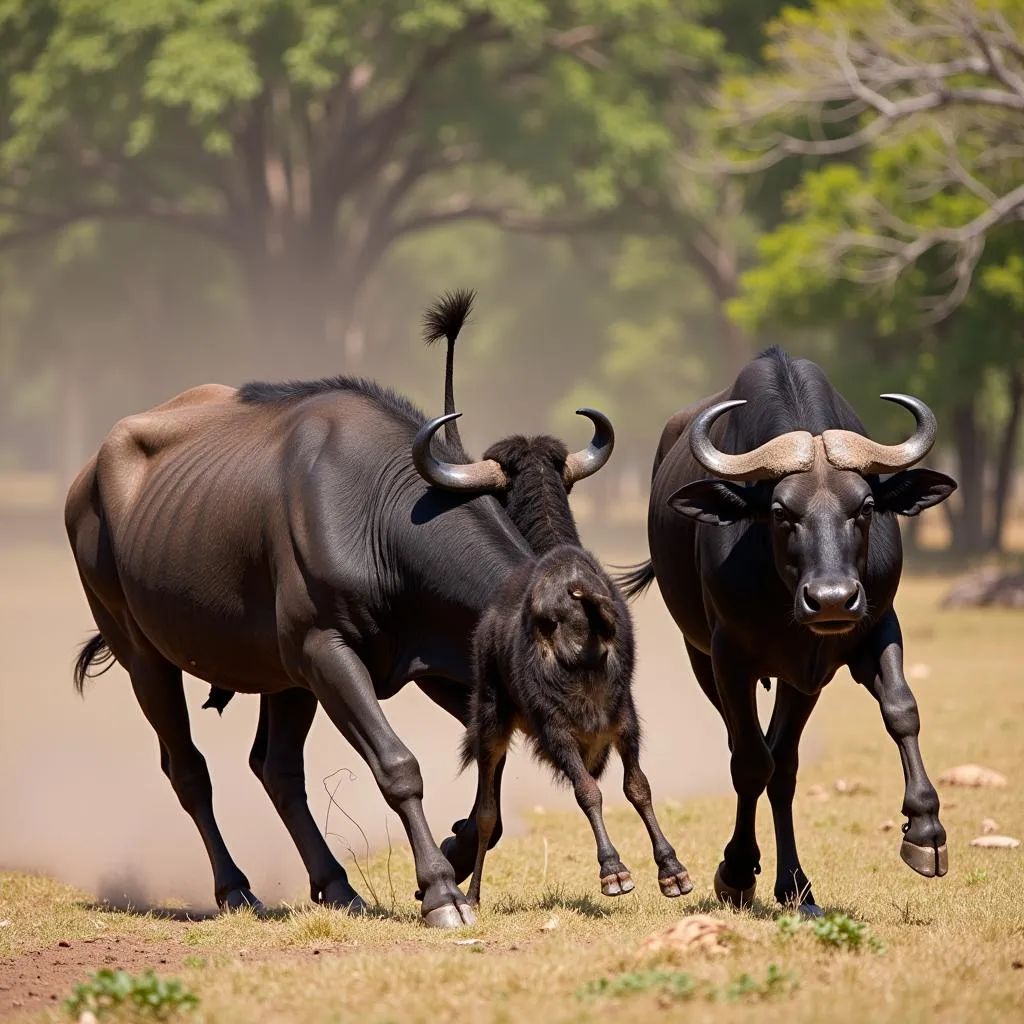African Buffalo Adaptations: A Look at the Survival Strategies of a Mighty Beast
The African buffalo, also known as the Cape buffalo, is a formidable and iconic creature that roams the savannas and grasslands of sub-Saharan Africa. These massive herbivores have evolved a unique set of adaptations that allow them to thrive in a challenging environment, from the scorching heat to the relentless attacks of predators. In this article, we will delve into the fascinating world of African Buffalo Adaptations, uncovering the secrets behind their survival and the intricacies of their evolutionary journey.
Physical Adaptations for Survival
The African buffalo’s imposing physique is a testament to its enduring strength and resilience. Its thick, muscular build, weighing up to 1,800 pounds, provides it with the necessary power to charge through dense vegetation and defend itself against predators.
Powerful Horns and a Thick Hide
Perhaps the most striking physical adaptation of the African buffalo is its massive horns. These formidable structures, often spanning over 40 inches, are a powerful deterrent to any potential attacker. They can be used to gore, toss, and even impale predators, effectively discouraging even the bravest of lions or hyenas.
Adding to their defenses, African buffalo possess a thick, leathery hide. This tough outer layer acts as natural armor, protecting them from the bites and scratches of predators. This thick hide is an integral part of their survival, making it incredibly difficult for predators to penetrate their defenses.
Built for Endurance
Beyond their imposing size, African buffalo are also built for endurance. Their muscular legs allow them to traverse vast distances in search of food and water, effortlessly navigating the terrain of the African savanna. Their hooves, specifically adapted for hard ground, help them maintain their agility and balance, even at high speeds.
Social Adaptations for Protection
African buffalo are not solitary creatures. They live in herds, often numbering in the hundreds, which provides them with an essential advantage in the wild.
Strength in Numbers
The buffalo’s social structure is a key element in their survival. By living in herds, they can collectively defend themselves against predators, with their formidable size and powerful horns presenting a formidable threat. The sheer number of individuals in a herd makes it challenging for predators to isolate and attack a single buffalo.
Alarm Calls and Group Defense
African buffalo are highly communicative, utilizing a system of alarm calls to alert other members of the herd to danger. These calls, ranging from low grunts to loud bellows, can quickly mobilize the herd, allowing them to move as a unified force to confront the threat. Their collective defense strategies, including forming a defensive circle around vulnerable individuals, have proven to be remarkably effective against predators.
Adaptations to the African Environment
The African buffalo has also evolved several adaptations to thrive in the harsh conditions of its native environment.
Water Conservation
The savannas of Africa can experience periods of prolonged drought. African buffalo have developed adaptations to conserve water, including their ability to survive on limited water intake for extended periods. They also use their large bodies to regulate their internal temperature, minimizing water loss through sweating.
Grazing Habits
The African buffalo’s grazing habits are another example of their adaptation to the African landscape. These herbivores are highly efficient grazers, capable of consuming large quantities of grass and other vegetation. Their strong teeth and digestive systems are well-equipped to process tough, fibrous vegetation, allowing them to thrive on the abundant grasses that characterize their habitat.
The Importance of African Buffalo Adaptations
The African buffalo’s adaptations are not merely fascinating aspects of their biology; they are crucial for the ecological balance of the African ecosystem.
Ecosystem Roles
As herbivores, African buffalo play a significant role in regulating vegetation growth and distribution. Their grazing habits help maintain the health and diversity of grasslands, providing habitats for other species and contributing to the overall health of the ecosystem.
Indicator Species
The African buffalo is often considered an indicator species, meaning its presence or absence can reflect the overall health of the ecosystem. Their populations can be sensitive to changes in habitat quality, water availability, and predator pressure. Monitoring their populations can provide valuable insights into the overall health of the African environment.
Challenges and Conservation Efforts
Despite their resilience, African buffalo populations have faced significant challenges, including habitat loss, poaching, and disease.
Human Impact
Human encroachment on buffalo habitats has led to a reduction in grazing lands, increasing competition for resources. Poaching for their horns and meat remains a significant threat, often driven by the illegal wildlife trade. Additionally, disease outbreaks, such as rinderpest, have decimated buffalo populations in the past.
Conservation Efforts
Conservation efforts are underway to protect African buffalo populations, including the establishment of national parks and reserves. These protected areas provide safe havens for buffalo herds, allowing them to thrive and play their vital role in the ecosystem. Community-based conservation programs are also helping to address the threats of poaching and habitat loss.
The Future of the African Buffalo
The future of the African buffalo depends on the continued efforts of conservationists and the commitment of local communities to protect these magnificent creatures.
The Importance of Preservation
The African buffalo is a symbol of Africa’s wildlife heritage, a testament to the power and adaptability of life on Earth. Their survival is essential for maintaining the ecological balance of the African savanna and ensuring the well-being of countless other species.
A Call to Action
By supporting conservation efforts and raising awareness about the importance of protecting African buffalo, we can help secure their future and preserve the biodiversity of the African continent.
 African Buffalo Herd in the Savanna
African Buffalo Herd in the Savanna
Frequently Asked Questions
Q: Why do African buffalo gather in herds?
A: African buffalo form herds for protection against predators. Their strength in numbers makes it difficult for lions, hyenas, or other predators to attack a single individual.
Q: What are the main threats to African buffalo populations?
A: African buffalo populations are threatened by habitat loss, poaching, and disease. Human encroachment on their natural habitat and the illegal wildlife trade pose significant challenges to their survival.
Q: What can be done to protect African buffalo?
A: Protecting African buffalo requires a combination of conservation efforts, including the establishment of national parks and reserves, community-based conservation programs, and strict anti-poaching measures.
Q: Are African buffalo dangerous to humans?
A: While African buffalo are generally peaceful herbivores, they can be dangerous if provoked or threatened. They are known to charge at perceived threats, and their powerful horns can cause serious injuries.
Q: What is the best way to observe African buffalo in the wild?
A: It is best to observe African buffalo from a safe distance, with the guidance of experienced safari guides. Respect their space and avoid making sudden movements or loud noises that could provoke them.
 African Buffalo Charging a Predator
African Buffalo Charging a Predator
Conclusion
The African buffalo is a remarkable creature, showcasing an array of adaptations that have allowed it to thrive in the challenging environment of the African savanna. From their powerful horns and thick hides to their strength in numbers and their grazing habits, these adaptations have played a crucial role in their survival. Understanding the importance of African buffalo adaptations is essential for preserving these majestic animals and the diverse ecosystem they inhabit. By supporting conservation efforts and raising awareness about their ecological importance, we can help ensure that future generations can continue to marvel at these magnificent creatures.


